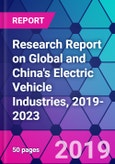Since 2014, the Chinese central government has been promoting the hybrid plug-in electric vehicle as a key product. Its subsidies concerning hybrid plug-in electric vehicles and battery electric vehicles are both based on the capacity of power battery. In addition, some local governments give a free license plate that is worth at most USD 10,000 or grant subsidies to each electric vehicle buyer. Thanks to these supportive policies, China's electric vehicle industry has been developing rapidly in recent years.
According to the author, in 2018, the global sales volume of electric vehicles (new energy vehicles) was about 2.02 million units, accounting for about 2.30% of the global automobile sales. In China, the sales volume of electric vehicles reached about 1,256,000 units, accounting for 4.50% of automobile sales. China has become the world’s largest electric vehicle market. By the sales volume of new energy vehicles, in 2018, Tesla ranked the first on the global market, followed by Chinese automakers BYD Auto Co., Ltd. that sold 227,364 new energy vehicles and Beijing Electric Vehicle Co., Ltd. The global rankings of electric vehicle manufacturers also included five Chinese automakers with self-developed brands, which took up a market share of 49%.
Considering the prices of electricity and refined oil products in China, it costs much less to drive a battery electric vehicle than to drive a fuel vehicle. However, the development of battery electric vehicles is restricted by a short driving range, expensive batteries, and insufficient charging stations. The plug-in hybrid electric vehicle popular in recent years is a new-type hybrid electric vehicle. It can be powered by a rechargeable battery. When the battery runs out, it can be powered by the internal combustion engine. The plug-in hybrid electric vehicle is superior to the battery electric vehicle in both endurance and practicability. However, Chinese consumers do not care much about endurance because they mostly drive electric vehicles in cities. Moreover, the Chinese government gives higher subsidies to the buyers of battery electric vehicles. Therefore, battery electric vehicles dominate China's electric vehicle market.
To reduce air pollution and enhance the competitiveness of domestic automakers, the Chinese government set the target of bringing the sales volume of electric vehicles to 7 million units, or at least one-fifth of the automobile sales in China by 2025. It is expected that the Chinese government will continue to directly subsidize the electric vehicle industry from 2019 to 2023, but the average subsidy amount will decrease and the subsidies will cover fewer vehicle models. In 2018, the central government canceled the subsidies for electric vehicles with a driving range below 150 kilometers. But as many Chinese cities restrict the purchase and passage of fuel vehicles and the use of electric vehicles costs less, from 2019 to 2023, the CAGRs of electric vehicle production and sales in China are expected to stay above 30%, far exceeding those of automobile production and sales.
Topics covered:
- Development environment for electric vehicles
- Industry chain of electric vehicles
- The Chinese government's supportive policies on the electric vehicle industry
- Annual and monthly production and sales volumes of electric vehicles in China
- Status of China's charging pile industry
- Status of China's Li-ion power battery industry
- Major electric vehicle manufacturers in China
- Competition on China's electric vehicle market
- Driving forces and market opportunities for the development of the electric vehicle industry
- Threats and challenges to the development of the electric vehicle industry
- Forecast on the supply of and demand for electric vehicles on global and Chinese markets from 2019 to 2023
Table of Contents
Samples

LOADING...
Companies Mentioned
- Anhui Jianghuai Automobile Group Corp., Ltd.
- BAIC Motor Corporation Ltd.
- Beijing Electric Vehicle Co., Ltd.
- BMW
- BMW Brilliance Automotive Ltd.
- BYD Auto Co., Ltd.
- Chery Automobile Co., Ltd.
- Chongqing Changan Automobile Co., Ltd.
- GAC New Energy Automobile Co., Ltd.
- Great Wall Motor Company Limited
- Haima Automobile Group Co., Ltd.
- Hawtai Motor Group
- Hyundai
- JMEV
- Kandi Electric Vehicles Group Co., Ltd.
- Linktour Motors Co., Ltd.
- Mitsubishi Motors
- Nissan
- Renault
- SAIC General Motors Corporation Limited
- SAIC Motor Passenger Vehicle Company
- SAIC-GM-Wuling Automobile Co., Ltd.
- Tesla
- Toyota
- Volkswagen
- Zhejiang Geely Holding Group
- Zhidou Electric Vehicle Co., Ltd.
- Zotye Automobile Co., Ltd.
Methodology
Background research defines the range of products and industries, which proposes the key points of the research. Proper classification will help clients understand the industry and products in the report.
Secondhand material research is a necessary way to push the project into fast progress. The analyst always chooses the data source carefully. Most secondhand data they quote is sourced from an authority in a specific industry or public data source from governments, industrial associations, etc. For some new or niche fields, they also "double-check" data sources and logics before they show them to clients.
Primary research is the key to solve questions, which largely influence the research outputs. The analyst may use methods like mathematics, logical reasoning, scenario thinking, to confirm key data and make the data credible.
The data model is an important analysis method. Calculating through data models with different factors weights can guarantee the outputs objective.
The analyst optimizes the following methods and steps in executing research projects and also forms many special information gathering and processing methods.
1. Analyze the life cycle of the industry to understand the development phase and space.
2. Grasp the key indexes evaluating the market to position clients in the market and formulate development plans
3. Economic, political, social and cultural factors
4. Competitors like a mirror that reflects the overall market and also market differences.
5. Inside and outside the industry, upstream and downstream of the industry chain, show inner competitions
6. Proper estimation of the future is good guidance for strategic planning.

LOADING...








